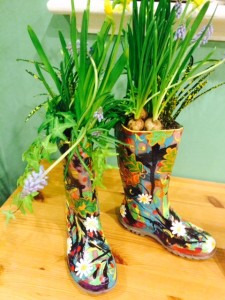Oakville Horticultural Society Flower Shows
May 2026 Show Schedule
Horticulture
- Bouquet of spring flowers, under 10″ in any direction – minimum of three cultivars. No foliage branches. Scilla siberica (Siberian squill) or Ornithogalum umbellatum (star of Bethlehem) are NOT
- Bouquet of Myosotis (forget-me-not)
- Iris – 1 scape
- Lamprocapnos, formerly Dicentra (bleeding heart) – 1 stem
- Muscari (grape hyacinth) – 3 stems, same cultivar
- Narcissus, trumpet/large cup, yellow – 1 scape
- Narcissus, trumpet/large cup, other colour – 1 scape
- Narcissus, multibloom – 1 scape
- Narcissus, other cultivars – 1 scape
- Perennial, small, growing height 15″ or under – 3 stems, same cultivar (guidelines p. 3-4)
- Perennial, large, growing height over 15″ – 1 stem
- Rhubarb – 3 stalks pulled; leaves trimmed to 2″
- Syringa (lilac) – 1 truss (Syringa vulgaris, common lilac NOT allowed)
- Seedlings – same cultivar, minimum 6 plants – 1 box or tray
- Tulipa (tulip), single red – 1 stem
- Tulipa (tulip), single pink – 1 stem
- Tulipa (tulip), single other colour – 1 stem
- Tulipa (tulip), ruffled or parrot – 1 stem
- Tulipa (tulip), lily flowered – 1 stem
- Tulipa (tulip), species – 1 stem
- Tulipa (tulip), other cultivar – 1 stem
- Any other cultivar not listed above (AOC)3 – 1 stem or bloom
Oakville Horticultural Society Flower Shows
Horticulture Guidelines
- Exhibitors are allowed three entries in each class, provided each specimen is a different cultivar/variety/species.
- All entries must be grown by the exhibitor.
- Specimens must be shown with their own attached foliage only.
- Where three specimens of the same cultivar are asked for, the specimens should be uniform, free of disease or insect damage and at a similar stage of maturity.
- Where a definite number of specimens is specified that number must be adhered to.
- Buds showing colour are considered blooms.
- When a height limit is specified for an annual or perennial, this refers to the growing height of the plant, not the cut length of the specimen.
- Houseplants must have been in the possession of the exhibitor for at least three months prior to the show and must not be shown more than once in any six-month period.
- Potted plants may have only one cultivar per pot unless stated otherwise.
- Plants should be clean and well-groomed. Insect-infested or diseased entries will be removed from the show.

